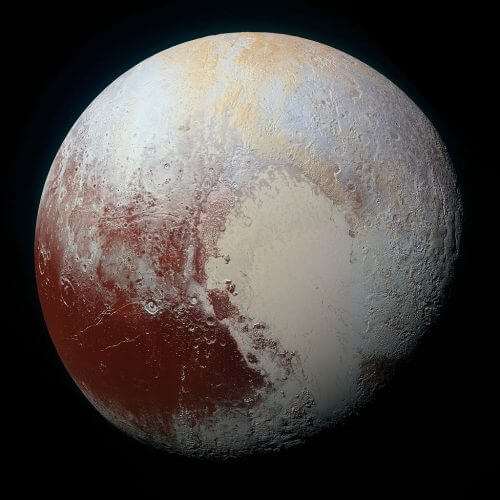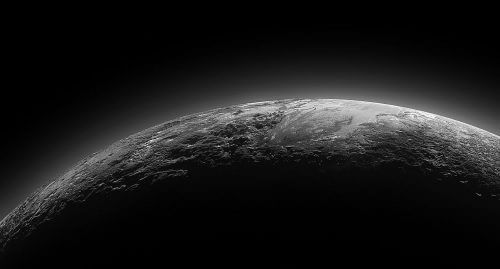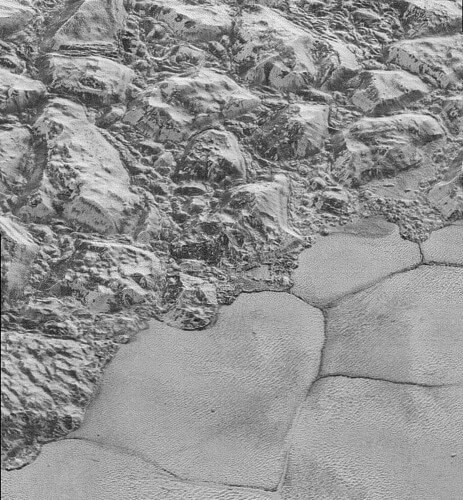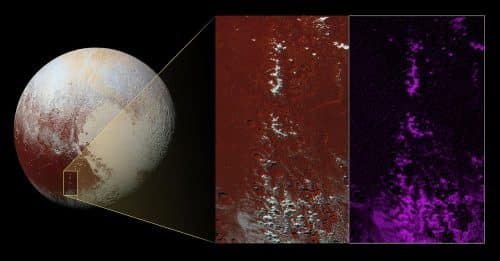Summary of findings from the New Horizons mission that passed last year near the dwarf planet Pluto

introduction
The New Horizons spacecraft was launched on January 19.1.2006, 10 towards the planet Pluto. After 14.7.2015 years on 12.500 she passed by him as planned. It is the only spacecraft that has explored this planet. The spacecraft was not designed to enter orbit around it and not to land on its surface. It was a transit flight and the transit distance was 72 km. At this point the photographs had a resolution of 1 meters/pixel (2). At the same time as the measurements of Pluto made by the spacecraft, terrestrial telescopes were aimed at it (2015). All the observations from the spacecraft and from the Earth complement each other. Since the spacecraft did not enter orbit around Pluto, only half of its surface was imaged. Towards the end of the spacecraft's mission in October 1.6, NASA began to think about another goal. Since a small stock of fuel remained in the spaceship, an optimal target that would meet this constraint had to be taken into account. The chosen target is a tiny Kuiper belt body that is 2014 billion km from Pluto. The body selected is 69MU1.1.2019. The expected meeting with him will be on 3 (50). The size of the body is 40-XNUMX km. It is estimated that this body will provide a first look at the raw materials that created the solar system.
atmosphere

Pluto, despite its tiny size, has an atmosphere. Although it is very sparse. Atmospheric pressure is 1 millibar. Like the Earth, this atmosphere also has a troposphere (4). Since the 80s of the 20th century, they knew that Pluto has an atmosphere made mainly of nitrogen with traces of methane and probably also CO2. Pluto's year is very long, it is equal to 248 earthly years and it also has seasons. With the coming of winter the atmosphere gradually freezes and accumulates on the ground like snow. With the arrival of summer as it is now (with the passage of the spacecraft near it) the snow immediately turns into gas. Until the arrival of the spacecraft it was possible to examine only the upper layer of the atmosphere with telescopic means. These observations showed that the temperature there is 170 degrees below zero, 50 degrees warmer than the ground. Only recently an ESO telescope discovered that the temperature in the upper atmosphere is 180 below zero. A little colder than they thought. It turned out that the higher you raise the atmosphere, the warmer it is. The changes are at a rate of 5-3 degrees per km. The amount of methane in the atmosphere is half a percent of it. Despite its small amount, methane plays an important role in the warming of the atmosphere. The observations showed that the amount of methane in the atmosphere is greater than they thought and attribute this to large patches of the gas on the ground (5).
Before the spacecraft's arrival, it was known that Pluto was losing nitrogen from its atmosphere at a rate of hundreds of tons per hour. The question asked is where he gets a constant supply of gas from. It is estimated that the nitrogen is brought to the surface from the interior of the planet probably through geysers or cryovolcanism (6). In terms of nitrogen, the spacecraft's findings surprised the researchers. The photographs showed that there is a 30 km long frozen lake of nitrogen on the ground. The photographs also show channels where liquid nitrogen probably flowed in the past. As strange as it may sound, Pluto used to have rivers of nitrogen, reminiscent of Titan's rivers of methane, which suggests that liquid nitrogen in terms of its geological activity resembles the weathering of water on Earth. The meaning is that in the past the atmosphere was more massive and thus the atmospheric pressure was greater and for some reason it was depleted. In this way it is reminiscent of the atmosphere of Mars. It should be taken into account that Pluto is inclined at an angle of 120 degrees beyond the inclination angle of the Earth 23.5. It is possible that in the distant past there were rains of nitrogen on Pluto in the high places (7). The researchers concluded that in the past the top of the atmosphere was 7 or 8 times higher than the diameter of Pluto compared to 2.5 times today. The escape of molecules from the atmosphere is lower than what was thought until now. And the mechanism responsible for this is the same for Earth and Mars (8). In the outflow from the atmosphere there are neutral atoms that can exchange electrons with the positive ions of nitrogen and carbon from the solar wind (9). Sunlight gives the atmosphere a blue color for the same reasons as it does on Earth (10).
Seasons
Pluto's orbit around the sun is extremely eccentric in its perihelion, its distance from the sun is 30 astronomical units, and in aphihelion, its distance from the sun is 50 astronomical units, therefore there are very significant differences between summer and winter in terms of temperatures. Observations made from Mauna Kea in Hawaii showed the temperature on the ground to be 233 degrees below zero instead of 223 degrees below zero. These measurements fit the model according to which the temperatures on Pluto are actually a balance point between the ice on the ground and its nitrogen atmosphere and not just due to solar radiation. The sunlight hitting the ground turns some of the nitrogen ice into a gas, more in this respect than the sun's heat itself. which hits the ground. Similar to the way water evaporation can cool the ground (11).
Pluto's orbit means that its summer season is very short. Towards the summer, the frozen gases undergo rapid sublimation. The source of the color of the soil in certain areas is a product of the residual hydrocarbons that originate from the influence of the sun's ultraviolet radiation (12). Telescopic observations made between 2002 - 1988 that the mass of the atmosphere doubles over the years. The reason for this lies in the warming and sublimation of nitrogen with the onset of summer. Observations with the Hubble telescope between 2003 and 2002 gave astronomers a very important tool in understanding Pluto's seasonal changes and the changes occurring in the atmosphere. When comparing these photographs with photographs taken in 1994 the researchers noticed that the North Pole became brighter and the South Pole became darker. These changes indicate complex processes that affect the appearance of the surface. As a whole it is a very dynamic planet from a climatic point of view (13).
On the ground there is ice of nitrogen, methane and CO. Due to the very thinness of the atmosphere, these gases do not pass towards the summer into a liquid accumulation state and hence into a gas, but directly into a gas. Of these gases, nitrogen is the most volatile. For this reason its sublimation is the fastest, followed by the CO and finally the methane. When nitrogen is cooled to below 237 degrees Celsius below zero, the nitrogen atoms change their crystalline phase from the hexagonal (6-faceted) crystal to the cubic (cubic) crystal. With warming the crystalline phase inverts. This phenomenon is known in the ice of volatile gases. Methane undergoes a crystalline change at 252 degrees below zero and CO at a temperature of 212 degrees below zero. Ethane ice, which is also found on the ground, has two crystalline phases at 183 degrees below zero and at 183.4 degrees below zero (14).
The ice of its kind on Pluto

The dominant component of the ice on Pluto is that of nitrogen. It turned out that this ice can move on the ground like glaciers on Earth. If this is indeed the case, it is possible that in places where the nitrogen ice is in motion, moraines will also be found (the author's hypothesis - Haim Mazar). According to the researchers, it could be that similar to the water cycle on Earth, there is a nitrogen cycle on Pluto. This nitrogen during its sublimation forms haze layers in Pluto's atmosphere (15).
One of the researchers hypothesized that the nitrogen lakes have existed for over 800 or 900 million years. The origin of the nitrogen lakes is related to the inclination angle of Pluto, 120 degrees. According to one of the models, Pluto's inclination millions of years ago was greater. If Pluto were a lying planet like Uranus, this angle of inclination meant that large parts of the surface were exposed to sunlight for longer, causing the nitrogen ice to melt and cause it to flow onto the surface. According to the same researcher's estimation, in the future, millions of years from today, there will be a flow of liquid nitrogen again. The question is how this will be possible at all due to the thinness of the atmosphere (16).
The spacecraft's instruments confirmed the existence of methane ice on the surface. The origin of the methane on Pluto is probably leftover material from the same nebula from which the solar system was formed (17). The distribution of the methane ice on the surface is not homogeneous. There is a large concentration of it in an area named Sputnik Planum. Another and smaller concentration of methane is found in another place to the southwest of it which received the name Cthulhu Regio (18). Methane ice is also found in bright plains and on the rim of craters. The origin of this brightness is unknown (19).
The red color of the Cthulhu Regio probably originates from the thulin that covers it. Photographs of the high mountains show that they are covered in lighter material.. It is believed to be methane when it turns to ice, which reinforces the view that methane acts like water in the Earth's atmosphere. which turns to frost at high altitudes (20). The highlands south of Piri Rupe are rich in methane. The sublimation of the methane probably causes the material deep in the rocks to undergo erosive processes. These rocks retreat south due to significant loss of rock material (21).

To the researchers' surprise, it turned out that there is more water ice on Pluto than they thought. It is found in many places in the mountains, in tectonic areas and in craters. The ice crust is very close to the surface and is below the nitrogen, methane and CO crusts. On the other hand, it is not found in the plains of Sputnik Planum(22). The amount of ice in Piri Planitia is greater than in the plateaus. It is found under the methane ice (21).
Glacier activity
The photographs show that the ice of its kind is not static, standing in place. There is a flow of glaciers similar to the Earth and it is also slow and indeed the photographs show valleys that have undergone weathering. Some of these valleys look like the hanging valleys found in Yellowstone in Wyoming, USA (23). The glaciers are very large and reach several kilometers in length. They are located across the plain named Sputnik Planum and the glaciers near the mountains are estimated to be smaller. Over time the ice blocks break, slide off the mountains and move with the sodium-rich ice. Convection currents bring them back towards the "coastline", where they form ice accumulations that are 20 km long. One such block measures 60 by 35 km and it has crushed many glaciers (24).
to the second part of the series
For the third part of the series
Sources
1. Nola Taylor – “Pluto's hidden ocean"18.11.2011
2. 'Assessing Pluto from afar"10.6.2014
3. 'Maneuver directs New Horizons towards next potential target"24.10.2015
4. Pluto: in depth
5. 'The lower atmosphere of Pluto revealed"3.3.2009
6. 'SWRI scientists study Nitrogen provision of Pluto's atmosphere"12.8.2015
7. Stannon Hull – “Frozen lake on Pluto points to a warmer time"31.3.2016
8. Stephen ClarkWeird mountains on Pluto may be volcanoes"9.11.2015
9. 'New Horizon's team releases detail slice of Pluto"19.12.2015
10. - "Weighs in on New Horizons Pluto discoveries"20.11.2015
11. 'Pluto is colder than it should be"3.1.2006
12. 'Pluto the full news release story"9.1996
13. 'Hubble catches Pluto changing with the years"5.2.2010
14. Will Grundy – “Its just a phase: Changes on Pluto's surface” 11..10.2014
15. Stephen Clark – “Hunting sunset vista shows foggy hazes on Pluto"17.9.2015
16. Evan Gough – “Ancient Pluto may have had lakes and rivers of Nitrogen"22.3.2016
17. George Dvorsky – “New Horizons has detected Methane on Pluto"7.1.2015
18. Stephen Clark – “"Secrets behind posted far from being answered" 24.9.2015
19. 'New snakeskin image and more from New Horizons"25.9.2015
20. Bob King – “Clouds seen on Pluto for the first time"5.3.2016
21. 'What's eating at Pluto?"15.3.2016
22. Stephen Clark – “Water ice abounds in Pluto's frigid bedrock"29.1.2016
23. 'New Horizons team releases detailed slice Pluto"19.12.2015
24. Sean O'Kane – “NASA discovers icebergs on Pluto"4.2.2016

4 תגובות
Hope you still learned something
Thanks for the information in science class, the teacher didn't see that I copied 🤣
The asteroid belt, the Kuiper belt and the Oort cloud are too sparse and weak to be an effective barrier against objects from outside the solar system that threaten to harm it. Just to clarify, the chance of a spacecraft being hit by an asteroid when it passes through the asteroid belt (the densest of the three) is less than one in a billion.
A few words could be said about the Kuiper belt, which is a shell at the edge of the solar system as we know it today that contains many bodies like Pluto or smaller. In my opinion, although I am not an astronomer (!!!) the belt had a protective role against asteroids coming from outside the system - they collide in the belt area and also do not reach inner stars. I wonder if there is another thin belt, obviously wider and wider around the solar system.